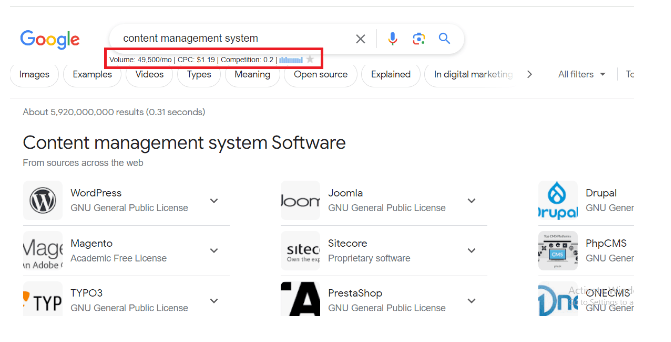A Content Management System (CMS) is a digital interface that makes creating and managing online content easy, even for novices who are not technical experts. It’s like a central hub for your website, from where you can easily edit, update, and even collaborate your work with others.
A CMS tool helps you keep your website looking good without messing with the backend design. It makes it easy to update things and ensures that users always have a consistent experience on your website.
On Google, the term “Content Management System” is searched over 49,000 times monthly. This number shows how crucial it is for business owners and startups to seek technical help to start a digital presence.


You do not need to know any coding to be able to set up their website, or make ongoing changes. You can carry out the tasks yourselves. For example, a restaurant owner can use a content management system to be able to update the restaurant’s website menu, prices, and promotions without ever needing to learn anything about computer coding. A CMS gives entrepreneurs and business owners the power to take control of their online presence efficiently and adapt quickly to the ever-changing digital world.
Features of a Content Management System
Here are some content management system features to look for:
-
User-friendly interface
A Content Management System (CMS) should have an easy-to-use interface that makes creating and editing content a breeze. It should offer a design, so you can easily understand how to update your content without technical expertise.
-
Content creation and editing tools
Content management software should have vital tools to allow you to create and edit content, making website management easy.
-
Customization options for tailored websites
For advanced needs, a good CMS tool should allow customizations to help you make a unique and attractive site to suit business needs. You should be able to easily change the design, colors, and features to match your business or brand needs.
Look for different types of themes and design template plugins to allow personalization of your site without any technical difficulty. This flexibility will help you control your online presence without the additional time and cost to contact a live web designer or web designing firm.
The adaptability and versatility of the desired customization will improve the user experience, bringing in more business.
How Does a Content Management System Work?
A Content Management Solution (CMS) makes creating, publishing, and managing digital content easy. You start by getting an account on a CMS system, log in, and learn to use their various interfaces to create and edit content using text editors, tools for pictures and videos, and more.
When your content is ready, add it in the selected web page templates and save. Your content and data gets stored in a database. Publishing is simple: you pick a date and schedule it, or do it right away with the click of a button.
CMS platforms often let you schedule updates so they happen automatically on time. In the background, the CMS transforms your content into a format that works on the web, creating pages on the spot.
For example, in WordPress, you write a blog post, add text and pictures, and set a publishing date. When you hit “Publish,” the CMS updates the database and creates the webpage for visitors. The CMS’s user-friendly design makes managing content accessible for everyone.
Some popular Content Management Systems
There are various Content Management Systems that meet specific needs, preferences, and price points. A small startup business may opt for a free CMS product to build a simple blog or static website. At the same time, a big company may need more customization tools and proprietary web page design, for which they may engage with a pricier plan with an advanced CMS. Further, some CMS systems may have eCommerce tools for saving favorites, shopping baskets, checkouts, and payment processing features.
You will find below a brief introduction of five content management systems (among many):
WordPress:
WordPress, initially a blogging platform, is loved by many because it’s as easy to use as Microsoft Word. It has lots of extra features you can add and is flexible. You can use it to build different kinds of websites, like blogs,forms,online courses, or online stores.
As the most popular CMS, hackers often try to attack businesses’ websites on WordPress. However, one sure way to stay safe and curb this is to ensure that you constantly update your WordPress plugins. (see screenshot below)

Joomla:
Joomla is a free and versatile tool for building websites of different kinds and touts multilingual support and multiple templates for varying looks. It strikes a good balance, is flexible and easy to use, and is suitable for beginners and developers. It’s one of those Content Management Systems that can work well for various website needs.
Drupal:
Drupal is a strong and flexible tool for creating big and complicated websites, and it can handle lots of data and content. Other features include its multilingual support and ability to build multiple user roles with varying permissions. It’s easy to customize and provides a strong foundation for developers.
Magento:
Magento is a well-liked CMS made just for online shops. Adobe bought it in 2018, which lends more credibility to it. It has robust features to help manage products, shopping carts, and other e-commerce tools. There are different versions of Magento, each with its strengths, some offering open-source development, and others allowing enterprises to integrate external applications and extensions (APIs). The latest major release is Magento 2.
Shopify:
Shopify is a widely used online store platform, although it’s not open-source. It works in the cloud and is well-liked for being easy to use. If you want a simple solution to start and manage an online store, Shopify is a great content management solution.
Factors to Consider when Choosing a CMS for your organization
Choosing the best Content Management System (CMS) for your organization is a big deal because it affects how well your site works and grows. It depends on what your project or organization needs.
Here are some essential factors to consider:
-
Content Requirements:
Know what content you want on your site. Different CMS are suitable for text, images, and videos. Ensure the content management software you choose can handle the pictures and dynamic content you want on your site. -
Ease of Use:
Check how easy it is to use the CMS. A good one should be simple for anyone to handle and update content with little training, even if they’re not tech-savvy. -
Scalability:
Think about your organization and website’s future growth. Thus, choose a content management system that can handle more content, visitors, and new features without slowing down. -
Customization and Flexibility:
Check how much you can change things with the CMS. A good one should let you customize how your site looks and works to fit your organization’s needs. -
Integration Capabilities:
See if the content management solution works well with your organization’s other tools, like CRM, e-commerce, analytics, and marketing automation tools. When things work together, it makes everything smoother and more efficient.
Also, you want to ensure the CMS you go with keeps things safe. It should have strong security to stop problems and ensure only the right people can get in. -
Community and Support:
Check how big and active the CMS community is. That means looking at how many people use the CMS and offering help. A big community means lots of helpful stuff like extras, support, and tips. Also, see if there are official ways to get help and info. -
Cost:
Consider how much it’ll cost you initially and over time. That may include fees for using the tool, hosting, and any extras you want. Some tools are free to use initially, but you might need to spend money making them work how you want and keep them running smoothly. -
Mobile Responsiveness:
Choosing a CMS that makes your site quick and easy for users to navigate is essential. That way, you foster efficiency in your business. -
Performance:
As more people use phones and tablets, choosing a CMS that facilitates mobile responsiveness is crucial to have your site look good and work smoothly on different-sized screens. -
Upgrades and Maintenance:
Check how easy it is to update the CMS and apply fixes and improvements. If it gets regular updates and has a strong community, that’s a good sign it’s a safe tool.
You can choose the suitable CMS for your business without confusion by carefully considering these things.
Advantages of a Content Management System
A. Ease of content updates and maintenance.
Websites are easier to manage with Content Management Systems (CMS). You can easily update and maintain your site even without technical knowledge.
For example, in WordPress, you can change text, pictures, and media without coding. It simplifies keeping your website up-to-date with little technical know-how, saving time and effort.
B. Collaboration capabilities for team-based projects
Working together on projects is more accessible with Content Management Systems (CMS). Platforms like SharePoint have tools to help teams, like keeping track of different versions and controlling who can do what.
That way, everyone can collaborate on documents smoothly, making the process more organized and efficient.
C. Scalability for growing businesses
As your business grows, Content Management Systems (CMS) can grow with you. For example, Magento can handle more products and visitors as your online store expands.
That means the system can adapt to your business’s importance, providing a solid base for adding more digital content and services. It’s a way to ensure your website keeps up with your business growth without hassle.
